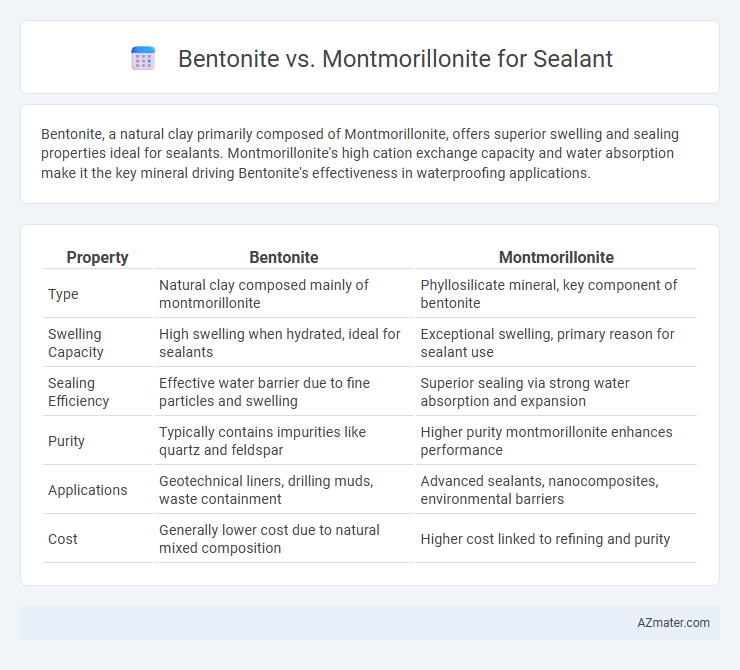Bentonite, a natural clay primarily composed of Montmorillonite, offers superior swelling and sealing properties ideal for sealants. Montmorillonite's high cation exchange capacity and water absorption make it the key mineral driving Bentonite's effectiveness in waterproofing applications.
Table of Comparison
| Property | Bentonite | Montmorillonite |
|---|---|---|
| Type | Natural clay composed mainly of montmorillonite | Phyllosilicate mineral, key component of bentonite |
| Swelling Capacity | High swelling when hydrated, ideal for sealants | Exceptional swelling, primary reason for sealant use |
| Sealing Efficiency | Effective water barrier due to fine particles and swelling | Superior sealing via strong water absorption and expansion |
| Purity | Typically contains impurities like quartz and feldspar | Higher purity montmorillonite enhances performance |
| Applications | Geotechnical liners, drilling muds, waste containment | Advanced sealants, nanocomposites, environmental barriers |
| Cost | Generally lower cost due to natural mixed composition | Higher cost linked to refining and purity |
Introduction to Bentonite and Montmorillonite as Sealants
Bentonite, primarily composed of montmorillonite clay, is widely used as an effective sealant due to its high swelling capacity and impermeability. Montmorillonite's ability to absorb water and expand forms a dense, watertight barrier ideal for containment and sealing applications. The structure and cation exchange properties of these clays make them critical materials for environmental sealing and construction projects.
Chemical Composition and Structure Differences
Bentonite primarily consists of montmorillonite, a smectite group mineral characterized by a 2:1 layer structure with two silica tetrahedral sheets sandwiching an octahedral alumina sheet, which allows significant water absorption and swelling properties. The chemical composition of montmorillonite is defined by its variable substitution of cations such as Mg2+, Fe2+, and Ca2+ in the octahedral and tetrahedral sheets, influencing its cation exchange capacity and plasticity essential for sealant applications. Bentonite's overall performance as a sealant depends on the purity and proportion of montmorillonite, where higher montmorillonite content results in enhanced impermeability and self-healing due to its layered structure and chemical reactivity.
Performance Comparison in Sealing Applications
Bentonite and montmorillonite are both used as sealants due to their excellent swelling properties and low permeability, but montmorillonite typically offers superior sealing performance because of its higher cation exchange capacity and finer particle size. Bentonite consists primarily of montmorillonite clay minerals, but variations in purity and mineral composition can impact its sealing efficiency, making engineered montmorillonite more reliable for critical applications like landfill liners and drilling mud seals. Montmorillonite's ability to absorb water and expand up to 15 times its original volume enhances its self-healing properties, providing a more durable and consistent barrier against fluid migration compared to generic bentonite.
Swelling Capacity and Water Absorption
Bentonite and Montmorillonite are both clay minerals noted for their high swelling capacity, essential for effective sealants in waterproofing and containment applications. Montmorillonite, the primary component of bentonite, exhibits superior water absorption due to its layered structure, allowing it to expand up to 15 times its dry volume when hydrated. Bentonite's swelling capacity, directly linked to montmorillonite content, enhances its performance as a sealant by creating an impermeable barrier that fills gaps and prevents fluid leakage.
Permeability and Barrier Efficiency
Bentonite and montmorillonite both exhibit low permeability, crucial for effective sealants in environmental and industrial applications. Montmorillonite, a principal component of bentonite, offers superior barrier efficiency due to its higher swelling capacity and fine particle size, creating a more compact and impermeable layer. Bentonite's natural composition, dominated by montmorillonite, ensures consistent low permeability, making it highly effective for landfill liners and slurry walls.
Durability and Longevity in Field Conditions
Bentonite, primarily composed of montmorillonite clay, exhibits exceptional swelling properties that enhance its sealant performance, making it highly durable in field conditions with fluctuating moisture levels. Montmorillonite's fine particle size and high surface area contribute to superior absorption and expansion, directly improving the longevity of bentonite-based sealants under environmental stress. Field studies indicate bentonite sealants maintain structural integrity and waterproofing effectiveness for decades, outperforming alternative materials in resistance to erosion and chemical degradation.
Environmental Impact and Safety
Bentonite and montmorillonite, both used in sealants, differ in environmental impact and safety due to their mineral compositions and processing methods. Bentonite, a natural clay primarily composed of montmorillonite, offers high swelling capacity and low toxicity, making it environmentally friendly and safe for applications like landfill liners and water barriers. Montmorillonite, as the active mineral in bentonite, provides excellent sealing properties with minimal environmental hazards, though its extraction and purification processes must be managed to reduce ecological disturbance.
Cost Analysis and Availability
Bentonite and montmorillonite are closely related clay minerals commonly used as sealants due to their swelling properties and low permeability. Bentonite, typically more abundant and widely distributed globally, generally offers a cost advantage over pure montmorillonite, making it more economical for large-scale sealing applications. Availability of bentonite deposits in major mining regions correlates with lower transportation costs, whereas montmorillonite, often extracted in more limited quantities, may incur higher prices and affect project budgets.
Industry Applications and Recommendations
Bentonite and montmorillonite are critical for sealing applications in industries such as oil and gas, construction, and environmental engineering due to their superior swelling and adsorption properties. Montmorillonite, the primary mineral component of bentonite, offers exceptional water retention and plasticity, making bentonite-based sealants ideal for landfill liners, drilling muds, and slurry walls. Industry recommendations emphasize choosing sodium bentonite rich in montmorillonite for enhanced sealant performance, ensuring durability and effectiveness in pollutant containment and fluid management systems.
Final Verdict: Choosing the Right Sealant
Bentonite and montmorillonite are critical components in sealant technology, with montmorillonite being the primary clay mineral within bentonite that provides exceptional swelling and sealing properties. Bentonite, rich in montmorillonite, offers superior absorption and expansion, making it highly effective for waterproofing and sealing applications in construction and environmental containment. For optimal sealant performance, selecting bentonite with high montmorillonite content ensures maximum durability, flexibility, and resistance to fluid penetration.

Infographic: Bentonite vs Montmorillonite for Sealant
 azmater.com
azmater.com